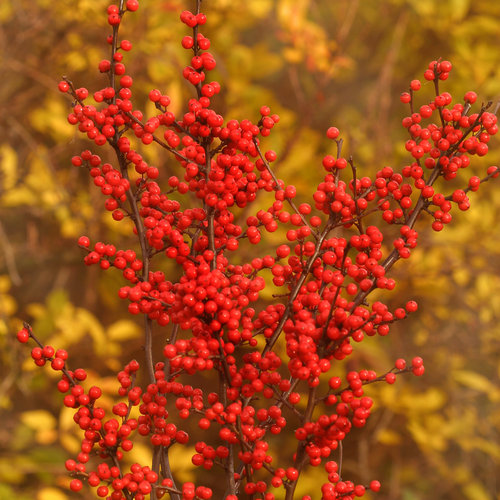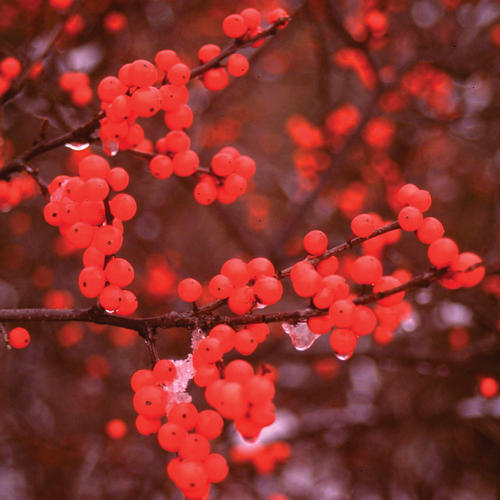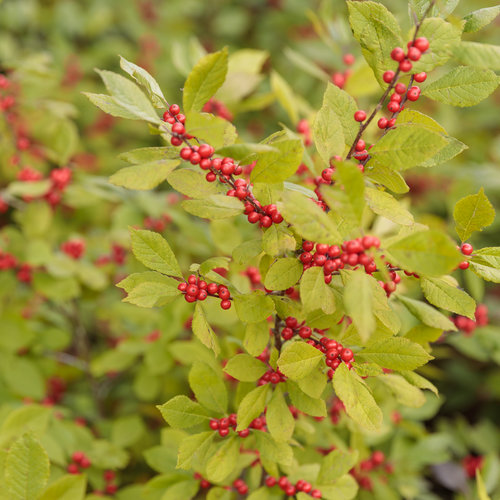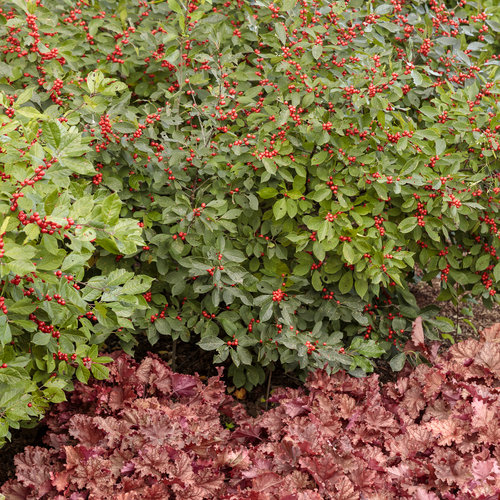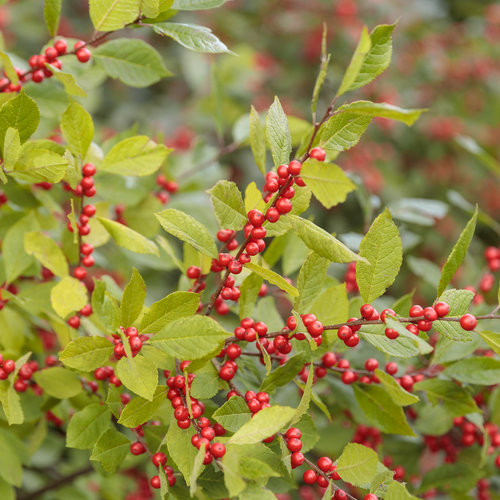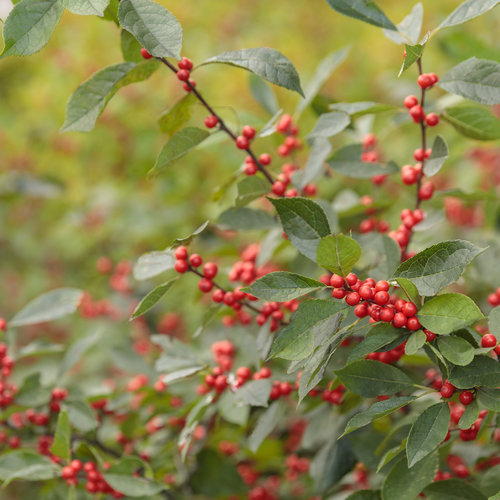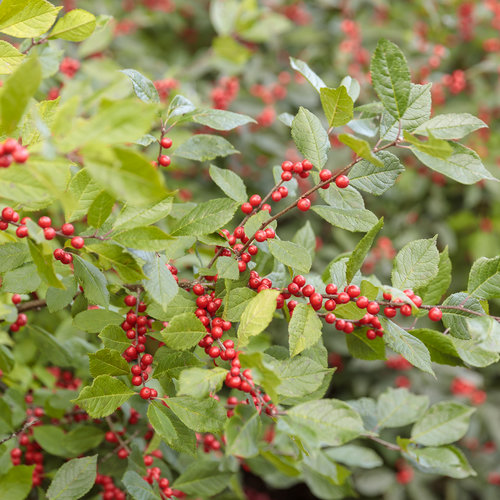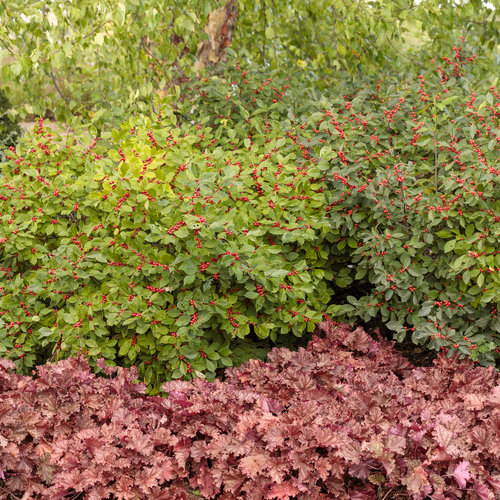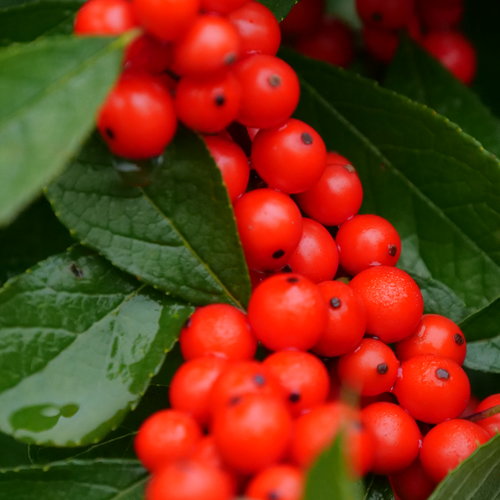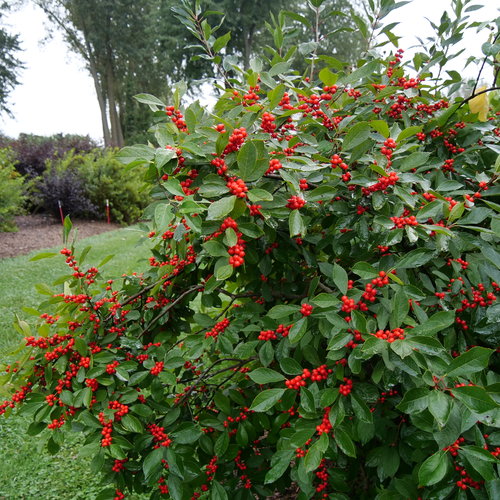This is a shrub for wet conditions; marsh, bog, streamside, lakeside or low area in the garden that collect lots of moisture. I"ve seen the native growing abundantly in standing water in northern Ontario. If you try to grow this plant in average garden conditions it will require lots of attention and constant moisture and will not survive even a short period of drought unless it is very well established. This plant needs close to full sun. It will do ok in part shade but anything less and it won't survive. The flowers are insignificant but the folliage is an attractive dark to medium green. The standout feature are the very showy red berries that persist into late fall and early winter. Seeing this shrub loaded with berries after a snowfall is striking; it's an image that belongs on the front of a Christmas card. By late winter the berries lose their colour and start to shrivel. The berries are not edible (I've occasionally seen birds take them, but probably because they've exhausted better options). The shrub is dioecious, so you will not get any decent flowering and berry broduction unless a male pollinator is planted close by (mine are within 20 feet). And be careful, there are many different cultivars of winterberry and you need to get a pollinator that flowers at the same time (and sometimes these aren't easy to find at the garden centre). I planted "Jim Dandy" to pollinate both my "Berry Heavy" and "Berry Nice" varieties. You can find a pollination chart here: https://www.skh.com/wp-content/uploads/2011/06/Winterberry-pollination.pdf
Berry Heavy® Winterberry Holly Ilex verticillata
- Part Sun to Sun
- Sun
- Fall
- Winter
-
72 - 96 Inches72 - 96 Inches72 - 96 Inches1.8m - 2.4m1.8m - 2.4m1.8m - 2.4m
Features
Heavy berry production for brilliant winter color!
Berry Heavy® winterberry produces copious amounts of bright red berries that really shine in the fall and winter landscape. It is a deciduous holly, which means it loses its leaves in fall, but this makes that vivid fruit even showier. The berries can also be cut for use in floral arrangements. To produce berries a male and female plant are both required - use Mr. Poppins® winterberry holly as the pollinator. Berries are not edible for humans but are relished by birds after they've softened in mid-winter. Native to North America.
Top reasons to grow Berry Heavy® winterberry holly:
- Sets more berries than conventional winterberry hollies
- Grows well in tough conditions, like shade and wet soil
- Adds color and interest to the winter landscape
- Attracts wildlife
Produces BerriesFall InterestWinter InterestDeadheading Not NecessaryBog PlantAttracts:BirdsResists:DeerNative to North AmericaCharacteristics
Plant Type:ShrubShrub Type:DeciduousHeight Category:TallGarden Height:72 - 96 Inches 1.8m - 2.4mSpacing:72 - 96 Inches 1.8m - 2.4mSpread:72 - 96 Inches 1.8m - 2.4mFlower Colors:WhiteFoliage Colors:GreenFoliage Shade:Dark GreenHabit:UprightContainer Role:ThrillerPlant Needs
Light Requirement:Part Sun to SunLight Requirement:SunThe optimum amount of sun or shade each plant needs to thrive: Full Sun (6+ hours), Part Sun (4-6 hours), Full Shade (up to 4 hours).
Maintenance Category:EasyBlooms On:Old WoodBloom Time:Late SpringHardiness Zones:3a, 3b, 4a, 4b, 5a, 5b, 6a, 6b, 7a, 7b, 8a, 8b, 9a, 9bWater Category:WetUses:Cut FlowerUses:LandscapeUses Notes:A good addition to mixed borders or cutting gardens. Beautiful for cuts to create holiday displays. Good in groupings and mass plantings, perennial and shrub borders, as a specimen, screen, or hedge. Good show in winter gardens. This plant tolerates wet conditions and may be used in bioswales and rain gardens.
Please Note: To produce berries, you'll need to plant Mr. Poppins®male winterberry holly as well.
Maintenance Notes:For complete information about growing and getting berries on winterberry holly, please see our Ultimate Guide to Winterberry Holly.
One male plant will pollinate up to 5 female plants; plant within 50' of one another to assure good pollination.
Adaptable to wet soils, does well in light and heavy soils. First class pick for planting in saturated areas.
It is best to avoid pruning winterberry hollies, except to remove whole branches for arrangements and decorating. Regular maintenance pruning or cutting back will impact the number of flowers and the quantity of fruit that the plant sets. Little pruning should be required, though very old branches can be removed in early spring if they are no longer producing vigorous growth.
According to the Humane Society of America Ilex berries can be toxic to pets. This is means that the plants are generally identified as having the capability for producing a toxic reaction.
Berry Heavy® Ilex verticillata 'Spravy' -
52413121Browse reviews from people who have grown this plant.
-
Doug Greenwood, Ontario, Canada, 4 years ago
-
Bought 6 quarts of this plus the male pollinator when we moved to a cabin on a mountain and all i knew of gardening was the clay soil was very wet. Today they are 5' and growing, all absolutely gorgeous shrubs! Never a problem, never needed water during hot summers, never a leaf scorch, disease, broken branch, etc. PERFECT in every way and attracting hundreds of pollinators and birds. Worth every penny and more- I'm buying more to place on another part of the garden!
Deca, United States, 6 years ago
-



